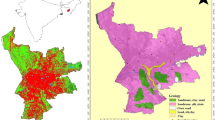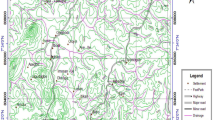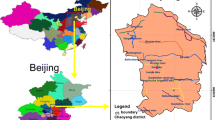Abstract
To evolve a proper management scenario for groundwater utilization, identification of groundwater vulnerability zones is a critical step. In the present study, an attempt has been made to identify plausible groundwater vulnerability zones based on DRASTIC, Agricultural DRASTIC, AHP (Analytic Hierarchy Process) DRASTIC and Modified DRASTIC methods in the Hirakud command area. The main objective is to determine vulnerability zones for groundwater pollution based on quantitative parameters with the help of geographic information system (GIS) platform. DRASTIC model is an integrated GIS based tool used to evaluate the groundwater vulnerability mapping. DRASTIC models use seven hydrogeological parameters: depth to water table (D), recharge rate (R), aquifer media (A), soil media (S), topography (T), impact of vadose zone (I) and hydraulic conductivity (C). Modified DRASTIC model is used to assess the groundwater vulnerability considering land use/land cover (LULC). Finally, vulnerability map is validated using water quality parameters (EC, Cl−, Mg2+ and SAR) over the study area. Moreover, DRASTIC vulnerability map indicate that the northern part of the study area is more vulnerable for groundwater pollution. Groundwater vulnerability is an important environmental concern that needs to be assessed for proper groundwater management. This analysis demonstrates the potential applicability of the methodology for a general aquifer system.






Similar content being viewed by others
References
Ahmed A (2009) Using Generic and Pesticide DRASTIC GIS-based models for vulnerability assessment of the Quaternary aquifer at Sohag. Egypt Hydrogeol J 17:1203–1217
Aller L, Bennett T, Lehr JH, Petty RJ (1985) DRASTIC: a standardized system for evaluating ground water pollution potential using hydrogeological settings. In: Robert SK (ed) Environmental Research Laboratory office of Research and Development. U.S Environmental Protection Agency, Ada, Oklahoma. EPA/600/2-85/018
Aller L, Bennett T, Lehr JH, Petty RJ, Hackett G (1987) DRASTIC: a standardized system for evaluating ground water pollution potential using hydrogeological settings. In: Robert SK (ed) Environmental Research Laboratory office of Research and Development. U.S Environmental Protection Agency, Ada, Oklahoma. EPA/600/2-87/035
Almasri M (2008) Assessment of intrinsic vulnerability to contamination for Gaza coastal aquifer, Palestine. J Environ Manag 88:577–593
Alonso J, Lamata T (2006) Consistency in the analytic hierarchy process: a new approach. Int J Uncertain Fuzziness Knowl Based Syst 14(4):445–459
Antonakos AK, Lambrakis NJ (2007) Development and testing of three hybrid methods for the assessment of aquifer vulnerability to nitrates, based on the drastic model, an example from NE Korinthia, Greece. J Hydrol 333:288–304
Arthur JD, Wood HA, Baker AE, Cichon JR Raines GL (2007) Development and implementation of a bayesian-based aquifer vulnerability assessment in Florida Nat Resour Res 16(2), DOI: 10.1007/s11053-007-9038-5
Baalousha H (2010) Assessment of a groundwater quality monitoring network using vulnerability mapping and geostatistics: a case study from Heretaunga Plains, New Zealand. Agric Water Manag 97(2):240–246
Babiker IS, Mohamed MAA, Hiyama T, Kato K (2005) A GISbased DRASTIC model for assessing aquifer vulnerability in Kakamigahara Heights, Gifu Prefecture, Central Japan. Sci Total Environ 345(1–3):127–140
Beynen PE, Niedzielski MA, Jelinska B, Alsharif K, Matusick J (2012) Comparative study of specific groundwater vulnerability of a karst aquifer in central Florida. Appl Geogr 32:868–877
Bojorquez-Tapia LA, Cruz-Bello GM, Luna-Gonzalez L, Juarez L, Ortiz-Perez MA (2009) V-DRASTIC: using visualization to engage policymakers in groundwater vulnerability assessment. J Hydrol 373:242–255
Brindha K, Elango L (2015) Cross comparison of five popular groundwater pollution vulnerability index approaches. J Hydrol 524:597–613
Central Groundwater Board (CGWB) (1998). Studies on conjunctive use of surface and groundwater resources in Hirakud irrigation project Odisha Ministry of Water Resources, Government of India
Chandoul IR, Bouaziz S, Dhia HB (2014) Groundwater vulnerability assessment using GIS-based DRASTIC models in shallow aquifer of Gabes North (South East Tunisia). Arab J Geosci. doi:10.1007/s12517-014-1702-6
Chen SK, Jang CS, Peng YH (2013) Developing a probability-based model of aquifer vulnerability in a agricultural region. J Hydrol 486:494–504
Dhar A (2013) Geostatistics-based design of regional groundwater monitoring framework. ISH J Hydraul Eng 19(2):80–87
Dhar A, Sahoo S, Dey S, Sahoo M (2014) Evaluation of recharge and groundwater dynamics of a shallow alluvial aquifer in central ganga basin, Kanpur (India). Nat Resour Res 23(4):409–422
Dhar A, Sahoo S, Mandal U, Dey S, Bishi N, Kar A (2015a) Hydro-environmental assessment of a regional ground water aquifer: Hirakud command area (India). Environ Earth Sci 73:4165–4178
Dhar A, Sahoo S, Sahoo M (2015b) Identification of groundwater potential zones considering water quality aspect. Environ Earth Sci 74:5663–5675 doi:10.1007/s12665-015-4580-7
Dixon B (2004) Prediction of groundwater vulnerability using integrated GIS-based neuro-fuzzy techniques. J Spat Hydrol 4(2):1–38
Ettazarini S (2006) Groundwater pollution risk mapping for the Eocene aquifer of the Oum Er-Rabia basin, Morocco. Environ Geol 51:341–347
Fijani E, Nadiri A, Moghaddam AA, Tsai FTC, Dixon B (2013) Optimization of DRASTIC method by supervised committee machine artificial intelligence to assess groundwater vulnerability for Maragheh-Bonab plain aquifer, Iran. J Hydrol 503:89–100
Foster S, Garduno H, Kemper K, Tuinhof A, Nanni M, Dumars C (2003) World Bank sustainable groundwater management: Concepts and tools, groundwater quality protection defining strategy and setting priorities. GW-MATE Briefing Note Series, World Bank, Washington, DC
Ghazavi R, Ebrahimi Z (2015) Assessing groundwater vulnerability to contamination in an arid environment using DRASTIC and GOD models. Int J Environ Sci Technol. doi:10.1007/s13762-015-0813-2
Guo Q, Wang Y, Gao X, Ma T (2007) A new model (DRARCH) for assessing groundwater vulnerability to arsenic contamination at basin scale: a case study in Taiyuan basin, northern China. Environ Geol 52:923–932
Hailin Y, Ligang X, Change Y, Jiaxing X (2011) Evaluation of groundwater vulnerability with improved DRASTIC method. Proc Environ Sci 10:2690–2695
Hallaq A, Elaish B (2012) Assessment of aquifer vulnerability to contamination in Khanyounis Governorate, Gaza Strip—Palestine, using the DRASTIC model within GIS environment. Arab J Geosci 5:833–847
Huan H, Jinsheng W, Yanguo T (2012) Assessment and validation of 10 groundwater vulnerability to nitrate based on a modified DRASTIC model: a case study in Jilin City of northeast China. Sci Total Environ 440:14–23
Iqbal J, Gorai AK, Katpatal YB, Pathak G (2015) Development of GIS-based fuzzy pattern recognition model (modified DRASTIC model) for groundwater vulnerability to pollution assessment. Int J Environ Sci Technol. doi:10.1007/s13762-014-0693-x
Jang CS, Chen SK (2015) Integrating indicator-based geostatistical estimation and aquifer vulnerability of nitrate–N for establishing groundwater protection zones. J Hydrol 523:441–451
Jasrotia AS, Singh R (2005) Groundwater pollution vulnerability using the DRASTIC model in a GIS environment, Devak-Rui watershed, India. J Environ Hydrol 13:11
Junior RF, Varandas SGP, Fernandes LFS (2015) Multi Criteria Analysis for the monitoring of aquifer vulnerability: a scientific tool in environmental policy. Environ Sci Policy 48:250–264
Katta B, Fares W, Charideh AR (2010) Groundwater vulnerability assessment for the Banyas Catchment of the Syrian coastal area using GIS and the RISKE method. J Environ Manage 91:1103–1110
Kazakis N, Voudouris, K (2011) Comparison of three applied methods of groundwater vulnerability mapping: a case study from the Florina basin, Northern Greece. In: Lambrakis N, Stournaras G, Katsanou K (eds) Advances in the research of aquatic environment. Environment Earth Sciences, pp 359–367
Kazakis N, Voudouris K (2015) Groundwater vulnerability and pollution risk assessment of porous aquifers to nitrate: modifying the DRASTIC method using quantitative parameters. J Hydrol 525:13–25
Kumar P, Bansod BKS, Debnath SK, Thakur PK, Ghansyam C (2015) Index-based groundwater vulnerability mapping models using hydrogeological settings: a critical evaluation. Environ Impact Assess Rev 51:38–49
Liggett LE, Talwar S (2009) Groundwater vulnerability assessments and integrated water resource management. Watershed Manag Bull 13(1):18–29
Lima ML, Zelaya K, Massone H (2011) Groundwater vulnerability assessment combining the drastic and Dyna-Clue model in the argentine pampas. Environ Manage 47:828–839
Mair A, El-Kadi AI (2013) Logistic regression modeling to assess groundwater vulnerability to contamination in Hawaii, USA. J Contam Hydrol 153:1–23
Mohammadi K, Niknam R, Majd V (2009) Aquifer vulnerability assessment using GIS and fuzzy system: a case study in TehranKaraj aquifer. Iran Environ Geol 58:437–446
Neshat A, Pradhan B, Dadras M (2014) Groundwater vulnerability assessment using an improved DRASTIC method in GIS. Resour Conserv Recycl 86:74–86
Odling NE, Serrano RP, Hussein MEA, Riva M, Guadagnini A (2015) Detecting the vulnerability of groundwater in semi-confined aquifers using barometric response functions. J Hydrol 520:143–156
Pacheco FAL, Pires LMGR, Santos RMB, Sanches Fernandes LF (2015) Factor weighting in DRASTIC modeling. Sci Total Environ 505:474–486
Pathak DR, Hiratsuka A (2011) An integrated GIS based fuzzy pattern recognition model to compute groundwater vulnerability index for decision making. J Hydroenviron Res 5:63–77
Pathak D, Hiratsuka A, Awata I, Chen L (2009) Groundwater vulnerability assessment in shallow aquifer of Kathmandu Valley using GIS-based DRASTIC model. Environ Geol 57:1569–1578
Prasad R, Singh VS, Krishnamacharyulu SKG, Banerjee P (2011) Application of drastic model and GIS: for assessing vulnerability in hard rock granitic aquifer. Environ Monit Assess 176:143–155
Rahman A (2008) A GIS Based DRASTIC model for assessing groundwater vulnerability in shallow aquifer in Aligarh, India. Appl Geogr 28(1):32–53
Saaty TL (1980) The Analytic Hierarchy Process: Planning, Priority Setting, Resource Allocation. McGraw-Hill, New York
Sahoo S, Dhar A, Kar A (2016) Environmental vulnerability assessment using Grey Analytic Hierarchy Process based model. Environ Impact Assess Rev 56:145–154
Secunda S, Collin M, Melloul A (1998) Groundwater vulnerability assessment using a composite model combining DRASTIC with extensive agricultural land use in Israel’s Sharon region. J Environ Manag 54:39–57
Shekhar S, Pandey AC, Tirkey AS (2014) A GIS-based DRASTIC model for assessing groundwater vulnerability in hard rock granitic aquifer. Arab J Geosci. doi:10.1007/s12517-014-1285-2
Shirazi SM, Imran HM, Akib S (2012) GIS-based DRASTIC method for groundwater vulnerability assessment: a review. J Risk Res 15(8):991–1011
Yang YS, Wang L (2010) Catchment-scale vulnerability assessment of groundwater pollution from diffuse sources using the DRASTIC method: a case study. Hydrol Sci J 55:1206–1216
Zhou J, Li G, Liu F, Wang Y, Guo X (2010) DRAV model and its application in assessing groundwater vulnerability in arid area: a case study of pore phreatic water in Tarim Basin, Xinjiang, Northwest China. Environ Earth Sci 60:1055–1063
Acknowledgments
Authors are thankful to the Regional Director, Central Ground Water Board (CGWB) South Eastern Region (SER) for providing necessary data for this research work. The author (AK& DC) are thankful to the Chairman, CGWB for his encouragement and permission to publish the paper. The Authors would like to thank the anonymous reviewers for providing valuable comments and suggestions to improve the quality of the paper.
Author information
Authors and Affiliations
Corresponding author
Rights and permissions
About this article
Cite this article
Sahoo, S., Dhar, A., Kar, A. et al. Index-based groundwater vulnerability mapping using quantitative parameters. Environ Earth Sci 75, 522 (2016). https://doi.org/10.1007/s12665-016-5395-x
Received:
Accepted:
Published:
DOI: https://doi.org/10.1007/s12665-016-5395-x




